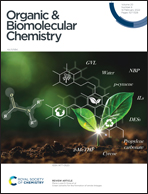Reaction-based fluorescence probes for “turn on” sensing fluoride ions†
Abstract
Introducing a weak covalent bond into an originally highly fluorescent molecule to create a non-fluorescent probe is able to provide a new way to detect some nucleophilic targets with enhanced sensitivity. Herein, this is the first time that a tetraphenylethene (TPE)-based probe (TPEONO2) bearing a p-nitrobenzenesulfonyl moiety for the sensing of F− ions in aqueous solution via a cleavage reaction of the sulfonyl ester bond to induce aggregation-induced emission (AIE) has been reported.



 Please wait while we load your content...
Please wait while we load your content...